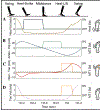Gait Kinematic Dependent Plantar Stimulation
- PMID: 40039559
- PMCID: PMC12035878
- DOI: 10.1109/EMBC53108.2024.10782134
Gait Kinematic Dependent Plantar Stimulation
Abstract
Vibro-tactile stimulation is often used to stimulate the plantar surfaces during walking to augment or replace the pattern of natural sensory feedback. However, many of these methods supply patterns of vibro-tactile feedback that are independent of the individual's real-time gait kinematics. If the purpose of the stimulation is to augment the natural feedback provided by the tactile receptors, the additional vibrations should change depending on the real-time movements similar to those natural receptors. For this reason, we created a method of applying plantar vibro-tactile stimulation through tactor embedded insoles that activate and deactivate based on the kinematic phases of walking in real-time. We demonstrate and validate a gait-like pattern of tactor activations. This pattern sequentially stimulates the plantar surfaces to follow the natural progression of the stance phases of walking. Gait events such as heel-strike, midstance, heel-lift, and toe-off were used to reliably drive a natural pattern of tactile stimulation across the plantar surface during walking. This real-time detection of gait events produced only small differences when compared to post-analysis detection methods. Overall, this controller can be used for a multitude of live feedback systems to attempt to better understand how real-time feedback is used during different tasks such as walking.
Figures




References
-
- Nurse MA and Nigg BM, “The effect of changes in foot sensation on plantar pressure and muscle activity,” Clinical Biomechanics, vol. 16, pp. 719–727, 2001, [Online]. Available: www.elsevier.com/locate/clinbiomech - PubMed
-
- Xie H, Song H, Schmidt C, Chang WP, and Chien JH, “The effect of mechanical vibration-based stimulation on dynamic balance control and gait characteristics in healthy young and older adults: A systematic review of cross-sectional study,” Gait and Posture, vol. 102. Elsevier B.V., pp. 18–38, May 01, 2023. doi: 10.1016/j.gaitpost.2023.02.013. - DOI - PubMed
MeSH terms
Grants and funding
LinkOut - more resources
Full Text Sources
Medical
